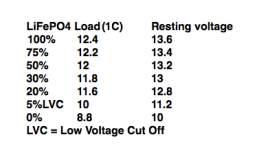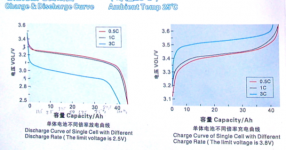I purchased the suggested smart charger for the battery It does full charge in 5.6 hours I believe? The battery and charger were $310 shipped to me.
what is the playtime duration in hours at war volume
Did a lot of research before spending the big bucks on LiFePO4.Art. that is a lot of info you got there !
Thanks
It is one thing to run out of tunes, quite another to push a 165 pound electric motorcyle home up hill
what is the playtime duration in hours at war volume
Kind of hard to calculate, lots of factors Involved. Guess ill find out once we hit the beach! I'm thinking this Sunday if the weather is nice here in NY
The 40 amp LiFePO4 battery pack can use as much as a 40 amp charger could put out (1C), but can be charged at any fraction of that charge rate.
A dedicated charger designed for LiFePO4 is the safest bet, as the individual cells must be charged at no more than 3.8 volts (15.2 volts for a nominal 12 V series pack of four) or they can suffer permanent damage.
A static voltage around 13.6 is fully charged on the LiFePO4.
Many "normal" 12v chargers can be used, but most will not bring the LiFePO4 battery pack up to full charge. But the 80% discharge rate far exceeds the safe discharge of 50% on a lead acid battery, even if the LiFePO4 is only charged to 12.6 v("full charge" on a LA) it will still carry a lot more usable juice.
Art
Art do you have any tables that show voltage vs charge percentage for LiFe batteries? Just curios so I know what percentage I'm at while using the radio....
I know that may be tricky when the radio is in use, because most tables are for resting voltage, not in use.
Just from the few times I checked over the weekend while using the radio, with the panels connected, in full sun, the voltage with the LiFe battery was still higher than even the big lead acid batteries were at full charge, In full sun!
Could be worse, run out of tunes and beer, and have to push a 165lb system homeIt is one thing to run out of tunes, quite another to push a 165 pound electric motorcyle home up hill..
Kind of hard to calculate, lots of factors Involved. Guess ill find out once we hit the beach! I'm thinking this Sunday if the weather is nice here in NY
Interesting stuff. My budget portable setup is a PPI P900.4 with a 12v 35ah SLA, bridged onto a single 4ohm sub and bridged to a 8ohm top. Passive preamp, PAC LC-1, with a sansa clip+ running rockbox, volume up to +6. Sub turned up all the way on the gains with a high pass well below tuning and the top half way up, at max volume runs for about 3 hours on a full charge, then the voltage slumps enough for the amp to cut out. Rocks pretty good, lol.
This weekend we ran out of juice, so we plugged in a 12v 6A charger in parallel to the battery to a honda eu1000 generator. Had to increase the highpass a good bit, and cut the volume to about +2 or +3 on the clip+, to keep the amp from cutting out. In the future, I will adjust the high pass on the sub more carefully, to around tuning, to avoid wasting power.
So figure I'm drawing ~12A at max output, or ~150w, which sounds about right, and (obviously) ~6A off the charger.
Figure your amps into your speakers will draw about 80-100w at full music output, so with the solar cells and battery, I'm going to guess a solid 7-8 hours!!!
Last edited:
Those things have a 12V output, don't they?honda eu1000 generator
Might be worth your time, if you'll be near one again, to make up a specific cable for running your rig off an EU generator
Those things have a 12V output, don't they?
Might be worth your time, if you'll be near one again, to make up a specific cable for running your rig off an EU generator
Yes...didn't notice before, though my friend may have mentioned it in passing. Looks like it's rated for 8A. Thanks!!
Kind of hard to calculate, lots of factors Involved. Guess ill find out once we hit the beach! I'm thinking this Sunday if the weather is nice here in NY
My rough guess for these things is...
full-tilt playback time in hours = (battery capacity in Ah)/(system quiescent current + 1/10 x maximum current draw, minus charge current from solar panels etc)
Reasoning is that, for most music, the peak-to-average ratio is around 10dB for a lot of music.
If you take 1/10 of the maximum current to be the average, the peaks will be at the onset of clipping, which is what I'd call full-tilt, as there's no more clean output to be had.
Chris
Last edited:
That may be roughly accurate for no solar panels involved, but throw them into the mix, turning the volume up or down etc things change. So that's why I said very hard to get a good idea of how long it will last.
Yeah, I edited the equation to include charging sources...
That equation will work for continuously running flat-out, so could be considered a minimum battery life.
That may be roughly accurate for no solar panels involved, but throw them into the mix, turning the volume up or down etc things change. So that's why I said very hard to get a good idea of how long it will last.
My estimate include the solar panels at rated power.
That would make sense, the LiFePO4 have a higher full charge voltage than LA batteries.Art do you have any tables that show voltage vs charge percentage for LiFe batteries? Just curios so I know what percentage I'm at while using the radio....
I know that may be tricky when the radio is in use, because most tables are for resting voltage, not in use.
Just from the few times I checked over the weekend while using the radio, with the panels connected, in full sun, the voltage with the LiFe battery was still higher than even the big lead acid batteries were at full charge, In full sun!
I have seen no state of charge tables for LiFePO4, the very narrow range from full charge to discharge makes it difficult to estimate.
I made my own chart, the one below is the second revision (version one resulted in me pushing the bike when I thought I had about 30% left
Your radio won't average 1C (40amp) draw, so your "load" voltage will be higher.
The LiFePO4 recover to a resting voltage much faster than LA.
If you don't have a LVC, get one, the LiFePO4 just go from good to nothing in a heartbeat.
A $25 LVC will save your batteries if you don't happen to be looking at your VOM when the sun goes behind a cloud and the voltage falls off the cliff.
Art
Attachments
Last edited:
This:
Smart Charger (10 A) for 12.8V LiFePO4 Battery Pack, Worldwide use, CE listed
Cut off the charge at right around 14.6. Hope that's not over charging the pack causing damage.
Smart Charger (10 A) for 12.8V LiFePO4 Battery Pack, Worldwide use, CE listed
Cut off the charge at right around 14.6. Hope that's not over charging the pack causing damage.
The individual cells can be charged to 3.8v, x 4 is 15.2 v.This:
Smart Charger (10 A) for 12.8V LiFePO4 Battery Pack, Worldwide use, CE listed
Cut off the charge at right around 14.6. Hope that's not over charging the pack causing damage.
14.6/4 is 3.65v, considered "safe" for these LiFePO4.
The topped off voltage drops from 14.6 to 13.6 very quickly which is why I used 13.6 as 100% charge in the state of charge chart, when 100% could actually be as high as 15.2v for a few seconds.
Good idea to initially check the individual cells, if one is not accepting charge, even at 14.6v finish some of the other cells can be overcharged.
I over discharged my pack, had to individually charge a few cells that went "over the cliff", they seem to have not suffered damage, but had me worried.
When I was testing my bike for distance, I individually tweaked all the cells to 3.8v, compared to just letting the charger quit at an average of 3.65v. It probably only amounted to a few % more distance covered, not worth the effort.
You can see in the discharge curve that anything above 3.2 volts per cell is gone in a hurry.
Attachments
- Status
- This old topic is closed. If you want to reopen this topic, contact a moderator using the "Report Post" button.
- Home
- Loudspeakers
- Subwoofers
- Beach Radio v5! (Sealed 3015LF sub)

